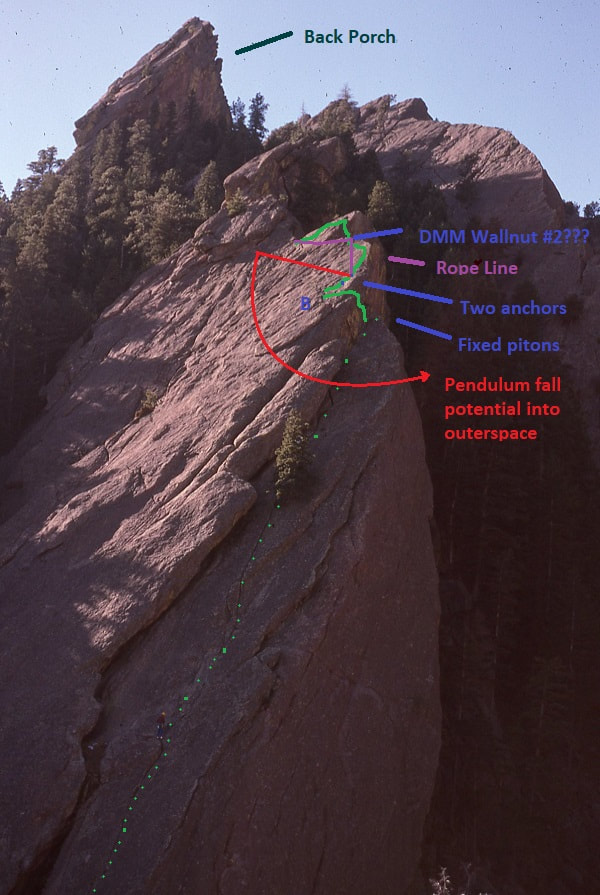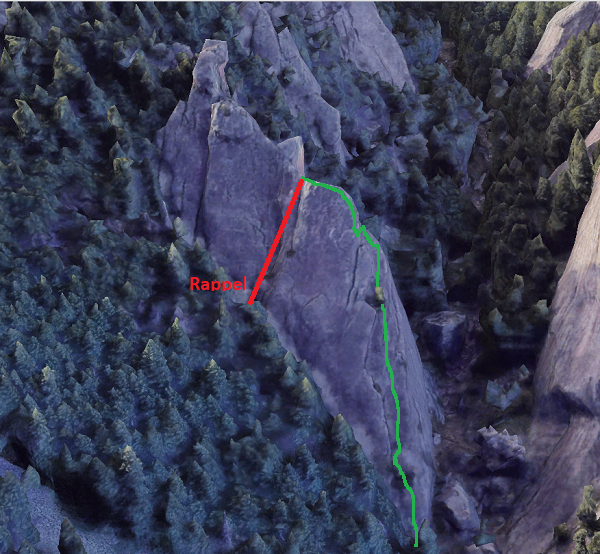Achean Pronouncement II, F7
Oh, that monster, looming in the back ground, how I wanted to climb that formation. Back Porch. Oh, how we looked at this climb from every possible angle. I looked at this climb. The broken bands, and overhanging slab edges, with really flaky rock. This is a sport climb situation without a bolt and no visible reliable anchor point that I can find. A rope without an anchor for safety and you might as well be free soloing. A practice I do not reccomend. You can easily view this climb from Front Porch, which has a fun class 4 ridge that hikers frequently use. But, I digress.
Achean Pronouncement
Climber on Achean Pronouncement (Photo taken while climbing Stairway to Heaven)
It was winter time, on a calm, overcast, foggy day with dew forming on our faces when we climbed this route. This was early spring and ground was kept damp from the late-melting snow, which accumulates and lingers in the shelter and shade. Walking along and approaching the climb, the pine needle floor was silently and hiding our footsteps as we looked toward the base, nestled in the shade, eyeing each other questioningly. We must have been tired of climbing "Stairway to Heaven," our inclement weather go to route because of it's sunny and breezy exposure. This was a first accent, and we had been accessing this climb often. For us to be attempting a first ascent, on a day like this, however, was really pushing it and looking very doubtful. As we approached the rounded, smooth boulder, to the start of the climb, the ground was very wet from a melting snow bank. The lichen was growing in large flakes and flaking off the rock. The crux of the climb is getting off the ground which is rated a 5.7 difficulty; and on a dry, sunny day, no problem. However, back when we were climbing, these routes saw very few climbers, and there was a lot of moss and lichen to hold moisture. Between "toothbrushing" footholds and handholds with climbing chalk, and drying my shoes, I eventually ascended over the rounded top, the physical crux, of the climb, and scrambled to a nice belay station and a good place to really start the main objective, a long, narrowing crack splitting a slab in two.
The climbing from here is the stuff of dreams among Flatiron climbs; an actual crack that screams "feed me," cams, hexes and stoppers. After so much face climbing it was a really nice change of pace. Once onto the face of the climb, the rock was sufficiently dry, and we were both pretty excited. The lower slab is longer that one rope length, so I set up a belay station under the tree that grows from the crack about three quarters the way up the lower slab. From there, both the crack and the slab narrow to nothing as you climb along the right hand facing dihedral until it ends. There were two old rusty pitons at what looked like a rappel at a very exposed belay station, at the time. My brother was definitely not thrilled with camping out on belay station that was not absolutely "bomb proof, while I climbed up over the dihedral face onto the slab above.
Fortunately, once onto the upper slab, there was a six feet wide flake with a comfortable, solid belay about 20 feet away (B), and I belayed my brother up, much to his relief. From here the climb presents technical problems that traversing the huge flake along the upper edge to the next belay. Proceeding from the belay, there were a couple of decent pieces of protection and things were looking pretty good. Unfortunately, that was all the protectable weaknesses I could find on the entire pitch, except one. As marked on the photo above, I found one outward flaring v shape which had a sharp quarts crystal protruding from one of the sides, that I managed to slot the groove of a #2 Wallnut over and wedge into place. This was nothing more than a rope guide, as I would not have trusted putting my body weight on it. At this point, the rope is psychological protection only and the prospect of falling when you are run out 40 feet on a traverse is not an option. Eventually that pendulum fall ends with an impact on the west face into who knows what. Also, this is also one of those situations when it is just as dangerous to climb second as leading, the pendulum just swings toward the lead (less severe in this case, as the pendulum shortens while climbing and swings onto the face). So, thoroughly committed at this point, I finished traversing the flake to an obvious crack and I set up a belay.
From here, we assessed the rest of the route to the summit, which looked pretty unimpressive with some loose, flaky looking stuff and not difficult climbing but decided not to "top out" as snow was beginning to fall. We looped some formation and rappelled down the slab face to the ground.

